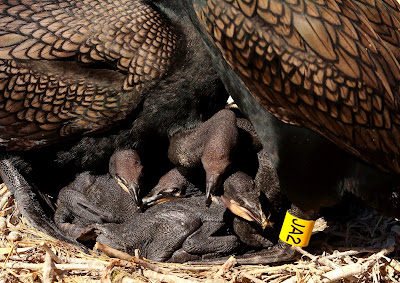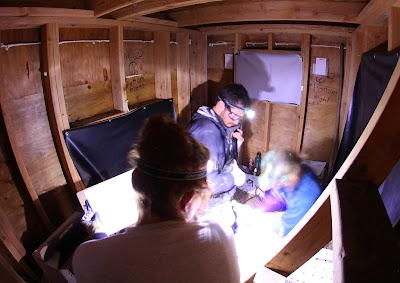
Not every day goes as planned. In fact some days seem
plagued with failure. Yesterday was one of those days. After a late start to
the harbor, we loaded camping equipment onto the boat and headed out in a light
rain to the island. The tide was high, so we took the faster approach around
the north end. It took two runs to transport all the gear, and by the time I
got the boat moored and had the dingy on the beach it was nearly lunch time. We
decided to finish up the final section of tunnels before breaking for a
sandwich. The pull start generator fired up right away and promptly died. It
was out of gas. Where was the spare gas tank? On the boat of course. So Carly
and I took the long walk down the beach to the dingy, dragged it to the water’s
edge, and prepared for the paddle out. The tide was going out, creating a swift
westward current along the shore. It’s not a far paddle to the moored boat, but
it can be difficult in a small inflatable boat with crappy oars. We made it out
to the boat with no problem, pulled up alongside, and grabbed the spare gas
tank.
Getting back to shore was another story. The current nearly carried us
past a line of old pilings and a rock jetty, beyond which is the open mighty
Columbia. Luckily we managed to paddle just inside the jetty in the lee of the
current, and walked the dingy along the shallow shore back to where we had launched.

Finally brought the gas back to the work site and I started
filling up the generator. The funnel was not quite in the hole and I was
spilling gas everywhere, and as I tried to adjust the angle failure number two
happened; the funnel slipped out of the hole dropping the tank to the ground.
Like a geyser gas gushed from the tank right into my face, getting all over my
head, eyes, and mouth. It burned more than I thought it would for a good five
minutes. Luckily we had water handy and were able to thoroughly flush out my
eyes, although I was now soaking wet both outside from the rain and
inside…along with smelling of gas.

No time to complain, I got back to work. Finished covering
the section of the tunnel, and worked on filling old tired with sand and nest
material to help encourage the cormorants to nest near the blinds and capture
windows. As we were filling the tires, the wind suddenly began to gust a good
20 knots, instantly creating whitecaps on the water. I joked around by yelling
“MICROBURST”, but in all honesty it was a similar feeling just on a smaller
scale. I initially thought a squall was passing through and it would lie down
again, but the wind just kept increasing. Turns out the low pressure system
that was scheduled to rear its ugly head later that evening had arrived early,
and the wind swiftly jumped to a sustained 30 knots. We thought we would be
stuck on the island until the system passed over – possibly overnight – but we
braved the wind and made it to land before the full force of the weather
settled in.
After a solid three weeks we have finished up prep on the
cormorant side of the island. Tunnels are covered, observation blinds secured
and windows cleaned, camp is basically set up, and the outhouse has been
installed. Now we just have to wait for the birds to settle in. There have been
a couple hundred Double-crested Cormorants and a handful of Brandt’s Cormorants
flying over the island all week, still have many thousands more to go. Caspian
Terns are filling in as well, some even with a fish in bill, practicing I guess
for when the chicks hatch in several months time. They nest on the east side of
the island, and have been loafing in healthy numbers on the eastern sandbar at
low tide amongst Ring-billed and Mew Gulls. We will be working on the Tern
Colony prep next, which should only take a week or so. It’s been many runs back
and forth from the harbor to the island hauling gear and trash, and I think it’s
safe to say that we’re all ready to get started on the biology aspect of this
project.

On a side note we've been seeing many Horned and Eared
Grebes in breeding plumage around the island, huge flocks of Surf Scoters, a
few Common Loons looking sharp with their white collars, pesky Bald Eagles that
roost on dead trees and pilings, and the occasional River Otter hauled out and
resting on the docks in the harbor. The weather has been mostly pleasant, with
the occasional wind storm.




















